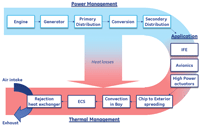
This trend in civilian aircraft has been preceded by a similar on-board power surge on military platforms. Increasingly powerful avionics, fly-by-wire, electronic warfare and radar systems have driven an accelerated demand and capability of on-board power systems. Considering the smaller dimensions of these military aircraft platforms, the trend of on-board power demand on a per-passenger or per-volume basis shows an even greater difference between military and civilian technology.
Increased Electrification Leads to Thermal Challenges
Although electrical systems are highly efficient, the sheer magnitude of on-board power demand and unique design aspects of on-board aviation systems lead to considerable thermal management challenges. Even if a 1 MW system were to be up to 95% efficient, a total of 50 kW of heat has to be removed without exceeding acceptable junction temperatures. This poses significant challenges to the thermal management system, as it has to remove the total capacity of waste heat with minimal temperature rise at a minimum of weight and volume.
Figure 3 illustrates how inefficiencies in electrical power management ultimately translate into increased challenges to the thermal management system. Significant thermal management is required at all levels of power management; generation, distribution, conversion power electronics(PE). At the application level heat is mostly produced by avionics, or, if present, actuators for flight control surfaces. Efficient thermal management is required for digital electronics, power electronics and Environmental Control Systems (ECS). It is not uncommon for these systems to be cascaded; meaning that heat rejected from one system is added to the heat load of a secondary system before being rejected to an ultimate heat sink such as fuel or air.
Thermal management solutions have to be developed at different hierarchically coupled levels:
• Application level thermal management of the avionics at the chip, board, and electronics frame, heat is rejected to the system level thermal management.
• System level thermal management of the bays and vehicle platform, including heat rejection to the ultimate heat sink
Aviation system thermal management solutions have specific requirements to be extremely reliable, have reduced specific weight/volume, and have a stringent operating window. Such systems often function in a controlled environment, depending on whether they are located in vented or unvented bays. Environmental conditions often include extreme temperature ranges, pressure variations, and the ability to withstand and operate during high g-force maneuvers. These specific requirements limit the applicability of Commercial-Off-The-Shelf (COTS) solutions.

Challenge of Heat Rejection for Aviation Platforms
In addition to the challenge of moving the heat efficiently to the convective surface, the ultimate rejection of heat is a challenge for aviation platforms. Airborne platforms practically have two heat sinks available, fuel and ambient air. Fuel is a convenient sink for several reasons. A large quantity of fuel is available and must be carried on the aircraft regardless. Heating fuel prior to it entering the engine combustor is advantageous to the engine efficiency, but thermal stability of conventional jet fuel limits this. If fuel thermal limits are exceeded, fuel can degrade by oxidizing reactions. As a result of oxidation, viscous deposits can form in the fuel lines. Such deposits can foul the heat transfer surfaces, leading to decreased heat transfer performance and/or decreased engine performance[5]. Fuel is a liquid with good heat transfer properties. Thus the volumetric flow rates, and the mass of the components needed to circulate, contain, and exchange heat with it are reasonable. Its compatibility with various needed components, as well as its compatibility for aviation environmental requirements is already well established because of its long-time use on aircraft. It is also straightforward to use in a primary/secondary loop type thermal management system where turbine oil, polyalphaolefin (PAO), glycol-water mixtures, or air can be used as the secondary coolant. Therefore, it is generally preferred that thermal losses associated with electrification and any other unwanted heat sources are rejected to the fuel. There are exceptions, for instance, if a component sits in the area of an aircraft where the ambient air can effectively accept the losses without the need of a scoop or other component that increases aerodynamic drag. In that case, there would not be a need to route fuel to that area.
The More Electric Aircraft (MEA) concept has pushed the use of fuel as a heat sink to the limit. For some short missions on military aircraft, the amount of fuel that will be carried is determined by the electrical heat load rejection capacity requirements rather than the estimated engine fuel consumption.
While there is a large amount of fuel on-board an aircraft, its use is not evenly distributed over the flight envelope. During ground idle and idle-descent the fuel flow is very low. During take-off it is extremely high. Thus the fuel flow to the combustor nozzles rarely matches the electrical loss removal demands required by an MEA. For instance, an aircraft electrical system often requires significant cooling during idle-descent when electrical loads are relatively high (actuation of flight control surfaces), but fuel flow is extremely low. To meet the cooling requirements, it is often required that the fuel is circulated back into the fuel tank after being used for cooling. This return-to-tank arrangement is common on military platforms. Using the fuel tank for thermal energy storage is convenient, but also has its limitations. At the beginning of the mission the hot fuel returning to tank does not significantly increase the overall temperature of the fuel in the tank because of the large thermal mass available. As the mission progresses and fuel levels are reduced, the high temperature return fuel has an increasingly greater effect of raising the temperature of the fuel in the tank. The latest military aircraft, and presumably future aircraft [6] (Figure 4), have such high cooling demands that even with the return-to-tank arrangement, the fuel simply does not have enough cooling capacity and alternative options such as fuels with improved thermal stability and refrigeration of fuel prior to take-off are being explored.
The other ultimate heat sink is the ambient air. Air is abundantly available around the aircraft. The quality of this air for use as a heat sink varies widely. On the ground, air can be extremely cold or hot. The air density at 2,700 meters is about 2/3 that at sea level, and at 5,500 meters 1/2 that at sea level. Although air at high altitude is cold, viscous heating in the boundary layer can be significant, especially at supersonic velocities. These factors combined make air a much less effective cooling fluid than fuel at high altitude, especially at high speeds. Typical environmental design requirements for electronics in unpressurized aircraft areas include being able to operate in conditions ranging from -55 °C up to +85 °C. The lower temperature includes extreme ground and high altitude conditions, while the upper temperature limit takes into account the temperature that can be obtained in the unpressurized aircraft bays.
).”]
Because of their long distance from the engines, and relatively high heat loads, civilian aircraft environmental control systems (ECS) often use ram air to cool the ECS condensers. In both military and civilian aircraft, surface or direct coolers within the engine fan bypass are often used to reject heat from the fuel and oil, decreasing the burden on the fuel as a heat sink.
As the need to reject heat to the ambient increases with increasingly more electric aircraft, traditional solutions such as fuel cooling and ram air-cooling become problematic. One of the major reasons for switching to MEA is decreased fuel usage. Rejecting the heat associated with MEA using traditional solutions results in excessive mass, drag, and ultimately fuel usage. It is clear that a system level approach is needed to trade-off possible solutions. In addition, new inventions in the area of heat rejection and thermal storage will be invaluable to finding the proper solution. There are various military and civilian programs that currently seek to address the issue at the system level, and progress is expected to continue in the upcoming years.
Conclusion
Aircraft such as the Airbus A380, Boeing 787, F-35, and F-22 have in common that they employ state-of-the-art systems requiring large amounts of on-board electrical power. Especially for military platforms, power demand has been rising sharply. Associated with this trend, is an increased need for efficient and optimized power conversion and distribution, and thermal management systems. High power electrical systems on aircraft flying at high-speed and high altitude present unique thermal challenges both at the application and system level. Efficiency improvements of the electrical components and thermal management system at the application level have the potential to be multiplied to greater benefits if the impact on the power and thermal management hierarchies are taken into account. Design of the thermal management solution can greatly benefit from a system-level approach to determine how to optimize the beneficial attributes of a component level improvement. Heat rejection remains an additional challenge under the conditions at which these aircraft operate. It is through advances in thermal management and system design engineering that key technologies are developed enabling operation of next-generation aircraft platforms.
References
[1] De Doncker, R., Pulle, D. and Veltman A., “Advanced Electrical Drives: Analysis, Modeling, Control”, Springer, New York, 2010.
[2] John Croft, “MRO USA: Engine Diagnostics: GE opens the envelope”, http://www.flightglobal.com/articles/2010/04/20/340710/mro-usa-engine-diagnostics-ge-opens-the-envelope.html, 2010.
[3] Gerstler, W.D., and Bunker, R.S., “Aviation Electric Power”. Mechanical Engineering, December 2008, pp 74-75.
[4] Moir, I. and Seabridge, A., “Aircraft Systems, mechanical, electrical and avionics subsystems integration”, 3rd edition, John Wiley & Sons, Chichester, England, 2008.
[5] Faith, L.E., Ackerman, G.H., and Henderson, H.T., “Heat Sink Capability of Jet A Fuel: Heat Transfer and Coking Studies”, Shell Development Co., S–14115, NASA CR–72951, 1971.
[6] USAF Scientific Advisory Board, “New World Vistas: Air and Space Power for the 21st Century”, Materials Volume, Washington, D.C., 1996.










